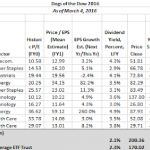Markets ended mixed over a month which witnessed a strong rotation out of tech stocks. In a widely anticipated move, the Fed hiked rates and provided details about how it intends to trim its balance sheet. The Trump administration introduced crucial legislations relating to health insurance and financial sector legislation which met with a limited amount of legislative success. Financials and healthcare stocks gained as a result of tighter rates and relaxation of regulations. Meanwhile, economic data continued to be worrying, particularly on the inflation front.
June’s Performance
For the month, the Dow and the S&P 500 registered gains of 1.6% and 0.5% respectively, while the Nasdaq declined 0.9%. Technology shares suffered several setbacks throughout the month on overvaluation concerns, dragging broader markets lower. The Fed hiked the key interest rate by 25 basis points on June 14, leading to gains for bank shares. Meanwhile, Senate released a new healthcare Bill on June 22 in an attempt to repeal key sections of Obama’s Affordable Care Act.
For the first half of the year, the Dow, the S&P 500 and the Nasdaq increased 8%, 8.2% and 14.1% respectively. The Dow and the S&P 500 posted their best performance for the first half since 2013, while the Nasdaq recorded its best performance for the same period since 2009. During the second quarter, the S&P 500 gained 2.6% while the Dow and Nasdaq increased by 3.3% and 3.9%, respectively.
Dismal Domestic Data
The majority of the data released in June led to heightened concerns about the state of the economy. The ISM Services Index declined to 56.9 in May while factory orders contracted by 0.2% in April. PPI remained flat during May even as CPI declined by 0.1%. Core CPI expanded by 0.1%, coming in below expectations. A 0.3% decline in May retail sales added to investor concerns. Industrial production remained flat in May while capacity utilization declined.
Durable orders dropped by 1.1% in May, declining for the second successive month. Worryingly, the PCE price index slipped 0.1% in May. Consumer expenditure increased by 0.1% in May, slower than the 0.4% pace of growth recorded in April.
On the positive side, the ISM Manufacturing Index rebounded to hit 54.9 in May. More importantly, consumers remained upbeat with the Consumer Confidence Index rebounding to hit 118.9 in June after declining in May.
Q1 GDP Better than Anticipated
As per the third estimate released by the Bureau of Economic Analysis on Thursday, the real gross domestic product (GDP) increased at a 1.4% annual rate in the first quarter of 2017. It also beat analysts’ estimate of an increase of 1.2% and was a significant improvement over the second estimate of 1.2%.
The third estimate also showed that first quarter personal consumption expenditures and exports rose more than previous estimation. Consumer expenditure increased by 1.1%, exceeding the earlier estimate of a rise of 0.6%. Exports increased by 7%, improving over earlier estimate of a rise of 5.8%.
Housing Data Mixed













Leave A Comment